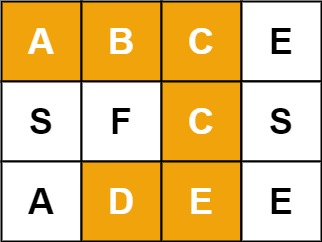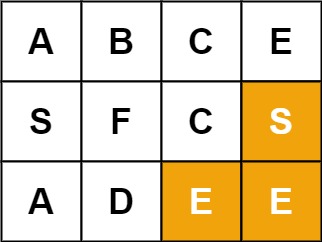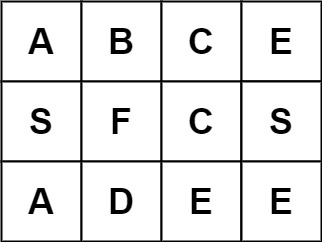LeetCode-in-All
79. Word Search
Medium
Given an m x n grid of characters board and a string word, return true if word exists in the grid.
The word can be constructed from letters of sequentially adjacent cells, where adjacent cells are horizontally or vertically neighboring. The same letter cell may not be used more than once.
Example 1:

Input: board = [[“A”,”B”,”C”,”E”],[“S”,”F”,”C”,”S”],[“A”,”D”,”E”,”E”]], word = “ABCCED”
Output: true
Example 2:

Input: board = [[“A”,”B”,”C”,”E”],[“S”,”F”,”C”,”S”],[“A”,”D”,”E”,”E”]], word = “SEE”
Output: true
Example 3:

Input: board = [[“A”,”B”,”C”,”E”],[“S”,”F”,”C”,”S”],[“A”,”D”,”E”,”E”]], word = “ABCB”
Output: false
Constraints:
m == board.lengthn = board[i].length1 <= m, n <= 61 <= word.length <= 15boardandwordconsists of only lowercase and uppercase English letters.
Follow up: Could you use search pruning to make your solution faster with a larger board?
Solution
bool dfsb(char **board, int mrow, int mcol, char *word, int crow, int ccol) {
// This means we are done with search
if (word[0] == '\0') {
return true;
}
// Out of bound check; search ends in this path
if (crow < 0 || ccol < 0 || crow >= mrow || ccol >= mcol) {
return false;
}
// Not found; search ends
if (board[crow][ccol] != word[0]) {
return false;
}
// Mark the cell as visited
board[crow][ccol] = '.';
// Check adjacent cells
if (dfsb(board, mrow, mcol, word + 1, crow, ccol + 1)) return true; // Right
if (dfsb(board, mrow, mcol, word + 1, crow, ccol - 1)) return true; // Left
if (dfsb(board, mrow, mcol, word + 1, crow - 1, ccol)) return true; // Up
if (dfsb(board, mrow, mcol, word + 1, crow + 1, ccol)) return true; // Down
// Undo marking if no match found
board[crow][ccol] = word[0];
return false;
}
bool exist(char **board, int num_rows, int *num_cols, char *word) {
for (int row = 0; row < num_rows; ++row) {
for (int col = 0; col < *num_cols; ++col) {
if (dfsb(board, num_rows, *num_cols, word, row, col)) {
return true;
}
}
}
return false;
}

